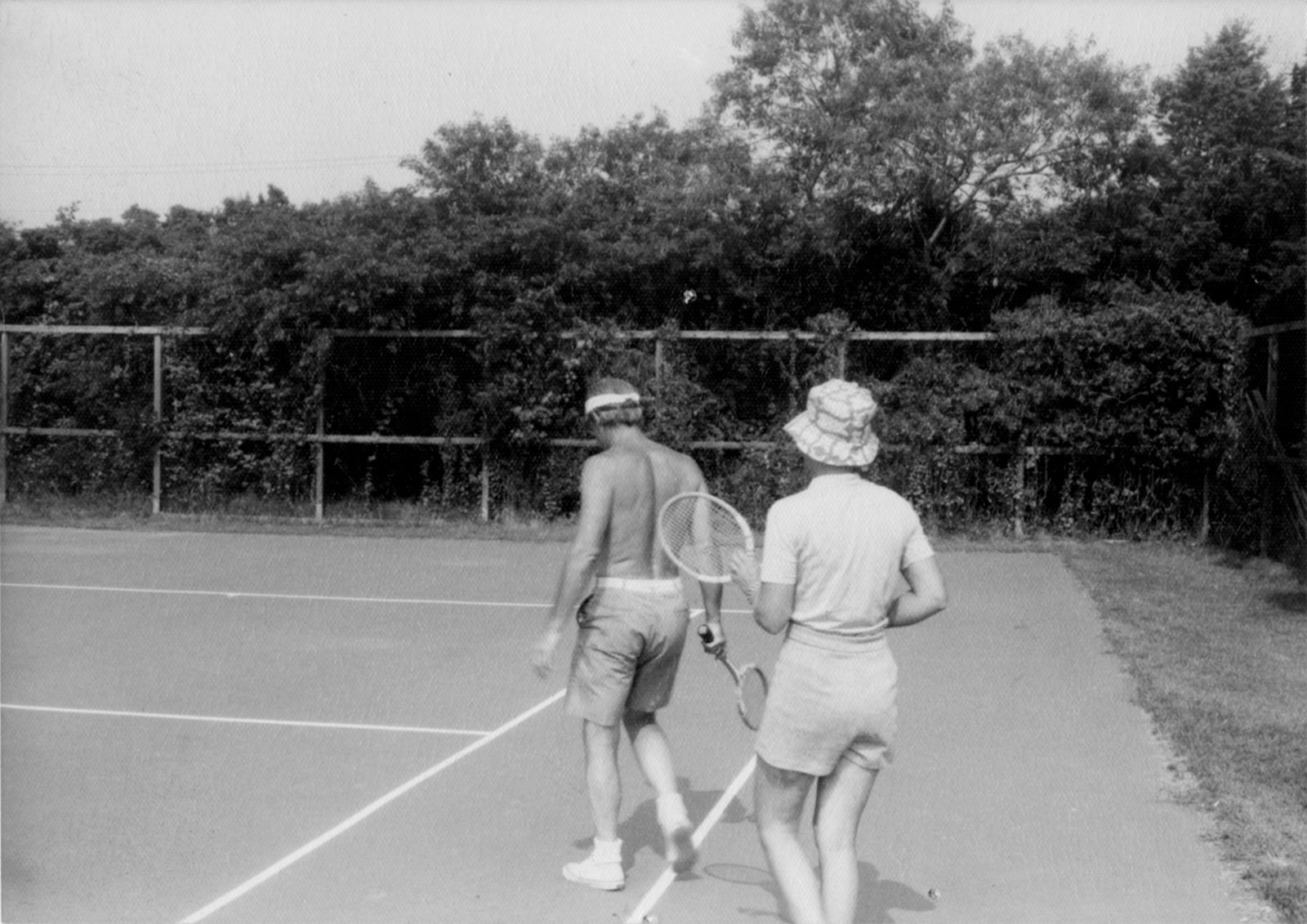For many years my late husband, Gardner Botsford, kept a small black-and-white snapshot on his desk of a man and woman wearing shorts, walking one behind the other on a tennis court. I didn’t know who the couple were but assumed they were friends from Gardner’s life before our marriage, people he had been close to and fond of. One day I asked him who they were and he laughed and said he had no idea. He had plucked the picture from a pile of rejects on their way to the wastebasket. It had leaped out at him as an example of an outstandingly terrible snapshot, one that had everything the matter with it. The couple had their backs to the camera; the tennis court showed a few white lines; there were undifferentiated shrubs and trees edging one side of the asphalt. That was all. I saw what my husband saw and laughed with him. There was no reason for the existence of this picture. Keeping it was a wonderful exercise in absurdism.
A few years later, in 1980, I had occasion to think of this picture in a new way. I was selecting illustrations for the title essay of Diana and Nikon, a collection of my pieces on photography, which had run unillustrated in The New Yorker. One of the key moments in the essay was a discussion of a new kind of avant-garde photography that took its inspiration—and to all intents and purposes was indistinguishable—from the home snapshot. Robert Frank, Garry Winogrand, Emmet Gowin, Lee Friedlander, Joel Meyerowitz, and Nancy Rexroth were among the practitioners of this school of deliberately artless photography that had recently been celebrated in a book called The Snapshot published by Aperture. In his introduction, the editor, Jonathan Green, felt impelled to inform the reader that the photographers represented in the book were “not snapshooters but sophisticated photographers.” The most sophisticated among them, perhaps, was Rexroth, who used a $1.50 toy camera called the Diana (thus my title) that also came in a model that squirted water when you pressed the shutter.
In Diana and Nikon I reproduced four pictures from The Snapshot to illustrate the new aesthetic. Except that one of the pictures was not actually from the book, but from Gardner’s desk: the snapshot of the couple on the tennis court. The temptation was too great. The gates stood too wide open. When the book appeared, there on pages 70–71, illustrating the work of The Snapshot’s “sophisticated photographers,” was a spread of four pictures with the captions under them of Joel Meyerowitz, Untitled; Robert Frank, Untitled; Nancy Rexroth, Streaming Window, Washington D.C., 1972; and G. Botsford, Untitled, 1971.
The reader may be wondering how this act of mischief could have gone undetected. Didn’t anyone at David Godine, the book’s publisher, notice? Or was the estimable and amiable Godine in on the mischief? As an A.J. Liebling character once said, “memory grows furtive.” I no longer remember how it was done or whether Godine knew. But I do remember that when Diana and Nikon was published, no one connected to The Snapshot ever wrote an indignant letter, or even a puzzled one. No one noticed at all. Then something occurred that gave me more pleasure than perhaps anything has before or since. A reviewer of my book, one who did not like it and was particularly irked by the “Diana and Nikon” essay, singled out the Botsford picture as a demonstration of my wrongheadedness, my pathetic inability to differentiate a work of art from an artless snapshot. I wish I had kept the review and could quote from it. But its delicious condescension is indelibly etched in my memory.
As if this wasn’t enough wicked joy for a single lifetime, four years later the Botsford picture was reproduced once again, this time in a historical and critical study of snapshots called Say ‘Cheese’! by a collector and critic named Graham King. In the chapter called “Snapshot Chic: How Contemporary Photography Snapped Up the Snapshot,” King covers some of the boggy ground I had covered in Diana and Nikon, and to illustrate the problem of telling real and fake snapshots apart, he offers a quiz in which eight images—among them the Botsford photo—are shown without identification. “Snapshot or imitation?” King writes.
These eight photographs are either anonymous snapshots or professional examples of “Snapshot Chic” photography. Can you guess which is which?…the answers are given on p. 212.
On p. 212 we learn that only three of the images are anonymous snapshots. The others—by William Eggleston, Joel Meyerowitz, Tod Papageorge, and Gardner Botsford—are “professional studies which are in important collections or which have been published.” I had built better than I knew. I look forward to the day when the picture of the couple on the tennis court will assume its place in an important collection, and I will take up mine in the annals of horsing around.
Advertisement
This Issue
July 19, 2018
Tipping the Scales
Düssel…




